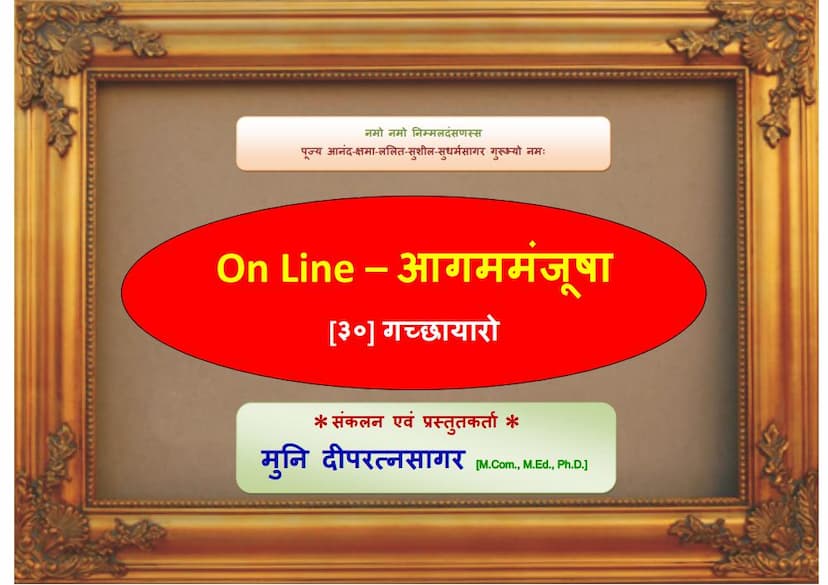Aagam Manjusha 30 Painnagsuttam Mool 07 Gachchhaayar
Added to library: September 1, 2025

Summary
This document is a Jain text titled "Aagam Manjusha 30 Painnagsuttam Mool 07 Gachchhaayar," compiled and presented by Muni Deepratnasagar. It is part of a larger work, "Aagam Manjusha," originally edited by Acharya Anand Sagar Suri 70 years prior to the 2012 online publication. This online version includes some updated content and formats.
The core of the text, "Gachchhaayar" (गच्छायारो), which translates to "Conduct of the Monastic Order" or "Code of Conduct for the Community," outlines the principles and practices that should be followed by monks and nuns within the Jain tradition. It emphasizes the importance of a righteous leader (Surí) for the monastic community and details the characteristics of both a good leader and a misguided one.
Here's a breakdown of the key themes and teachings presented in the text:
The Importance of a Righteous Community (Gachchha):
- The text stresses that a well-established and righteous monastic community (Gachchha) is crucial for spiritual progress and salvation.
- Living within such a community, dedicated to the teachings of Mahavira, leads to spiritual liberation.
Characteristics of a Good Leader (Surí):
- A good leader is described as knowledgeable, virtuous, compassionate, and unwavering in their adherence to Jain principles.
- They possess the ability to guide their followers with wisdom and insight.
- They are skilled in interpreting scriptures and practical application of vows.
- They are detached from worldly possessions and desires.
- They are patient, self-controlled, and possess the ten virtues of conduct (Dashavidh Samayachari).
- They prioritize the spiritual well-being of their disciples above all else.
Characteristics of a Bad Leader and a Corrupt Community:
- A misguided leader is characterized by their self-indulgence, disobedience, attachment to worldly affairs, and violation of vows and ethical conduct.
- The text warns against leaders who are deceitful, indulge in violence (even subtle forms), are biased, and lead the community astray.
- It highlights the dangers of associating with those who deviate from the path of righteousness.
Guidance for Monks and Nuns:
- Discernment: Monks and nuns are advised to be vigilant and discerning, to identify and avoid leaders and communities that are not following the true path.
- Association: The text emphasizes the importance of associating with virtuous and knowledgeable individuals and avoiding those who are corrupted or leading others astray.
- Vows and Conduct: Strict adherence to vows (Samyama), ethical conduct (Achara), and detachment (Vairagya) is repeatedly stressed.
- Self-Control: The importance of controlling one's senses and mind is a recurring theme.
- Scriptural Knowledge and Practice: The text advocates for understanding and practicing the teachings of the scriptures.
Specific Examples and Warnings:
- The text provides detailed descriptions of negative behaviors to avoid, such as:
- Disrespecting elders and learned individuals.
- Engaging in gossip, arguments, and worldly discussions.
- Indulging in luxurious living, accepting forbidden items, and deviating from scriptural rules regarding food, clothing, and dwelling.
- Displaying vanity, engaging in frivolous activities, and showing attachment to physical appearance.
- Mistreating or disrespecting the monastic order, especially the elders and the learned.
- Women monks (Samani/Arya) exhibiting unseemly behavior, engaging in gossip with householders, or displaying attachment to worldly things.
- Monks (Shraman/Muni) exhibiting similar lapses in conduct.
- The text uses strong language to condemn such deviations, often stating that those who follow such paths are doomed to the cycle of birth and death (Samsara).
The Role of the Preceptor (Gachchhadhipati/Surí):
- The preceptor is considered the "eye" of the community.
- They are responsible for upholding the teachings and guiding the community towards salvation.
- A preceptor who leads the community astray causes immense damage to the spiritual progress of many.
Overall Message:
The "Gachchhaayar" serves as a comprehensive guide for maintaining the purity and integrity of the Jain monastic order. It emphasizes the critical role of righteous leadership, disciplined conduct, and unwavering adherence to the core principles of Jainism for achieving spiritual liberation. The text acts as a warning against any deviations that could lead to spiritual downfall, encouraging followers to diligently uphold the righteous path.